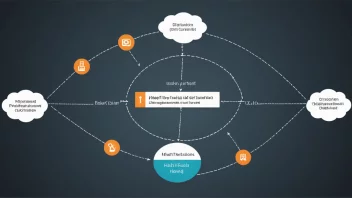The advent of blockchain technology has sparked a revolution across various industries, and the public sector is no exception. As governments and public institutions grapple with the challenges of transparency, efficiency, and trust, blockchain offers innovative solutions that promise to transform governance. This article delves into the intricacies of blockchain technology, its applications in the public sector, and the potential benefits and challenges it presents.
Understanding Blockchain Technology
At its core, blockchain technology is a decentralized ledger that securely records transactions across multiple computers, ensuring that the recorded data is immutable and transparent. Each transaction, or block, is linked to the previous one, forming a chain that cannot be altered without consensus from the network. This decentralization is what makes blockchain particularly appealing for public sector applications, as it reduces the risk of fraud and corruption.
Key Features of Blockchain
- Decentralization: No single entity controls the entire network, which mitigates the risk of centralized corruption.
- Transparency: All transactions are visible to participants, fostering trust among stakeholders.
- Immutability: Once a transaction is recorded on the blockchain, it cannot be altered or deleted, ensuring data integrity.
- Security: Advanced cryptographic techniques protect the data from unauthorized access and cyber threats.
Applications of Blockchain in the Public Sector
Governments around the world are exploring various applications of blockchain technology to enhance governance and public services. Here are some notable examples:
1. Digital Identity Management
Blockchain can provide a secure and immutable platform for digital identity management. By allowing citizens to control their own identities, governments can reduce instances of identity theft and fraud. Projects like Estonia’s e-Residency program exemplify the use of blockchain to create digital identities that streamline access to public services.
2. Land Registry
Land ownership is often fraught with disputes and bureaucratic delays. Blockchain can simplify land registries by providing a transparent and permanent record of ownership. Countries such as Sweden and Georgia have already implemented blockchain-based land registries, significantly reducing the time and cost associated with property transactions.
3. Voting Systems
Ensuring fair and transparent elections is a cornerstone of democratic governance. Blockchain technology can enhance the integrity of voting systems by providing a secure, tamper-proof record of votes. Projects like Voatz have piloted blockchain voting in various jurisdictions, allowing citizens to vote securely via their smartphones, thus increasing voter participation.
4. Supply Chain Transparency
Governments can use blockchain to track the supply chain of public goods and services, ensuring that products are sourced ethically and sustainably. For example, the U.S. Department of Agriculture has explored blockchain to track the supply chain of agricultural products, enhancing food safety and reducing fraud.
5. Public Records Management
Blockchain can streamline the management of public records, such as birth and death certificates, marriage licenses, and business registrations. By digitizing these records on a secure blockchain, governments can improve access for citizens while reducing administrative overhead.
Benefits of Implementing Blockchain in Governance
The integration of blockchain technology into the public sector offers several advantages:
- Enhanced Transparency: With all transactions visible on the blockchain, citizens can hold governments accountable, fostering trust and engagement.
- Improved Efficiency: By automating processes and reducing the need for intermediaries, blockchain can streamline operations and reduce costs.
- Greater Security: The decentralized nature of blockchain makes it less susceptible to cyberattacks and fraud.
- Increased Accessibility: Blockchain can provide citizens with easier access to public services and information, particularly in underserved communities.
Challenges and Considerations
Despite its potential, the adoption of blockchain in the public sector is not without challenges:
1. Regulatory Framework
The lack of a comprehensive regulatory framework can hinder the implementation of blockchain solutions. Governments must develop clear guidelines that address data privacy, security, and liability.
2. Interoperability
Different blockchain platforms may not be compatible with each other, creating challenges in data sharing and collaboration among public agencies.
3. Public Awareness and Acceptance
For blockchain initiatives to succeed, there must be a concerted effort to educate the public about the technology and its benefits. Building public trust is essential for widespread adoption.
4. Technical Expertise
Implementation of blockchain solutions requires skilled personnel who understand both the technology and its implications for governance. This may necessitate investment in training and development.
Case Studies of Blockchain in the Public Sector
Several governments have successfully implemented blockchain solutions, serving as models for others:
1. Estonia
Estonia is often cited as a pioneer in digital governance. The country has implemented blockchain technology across various public services, including e-Residency, digital voting, and land registries. This has resulted in increased efficiency, reduced fraud, and enhanced citizen engagement.
2. Georgia
Georgia has transformed its land registration process by implementing a blockchain-based system. This has streamlined property transactions, reduced disputes, and improved transparency in land ownership.
3. Dubai
Dubai aims to become the world’s first blockchain-powered government by 2020. The city has initiated multiple blockchain projects, including smart contracts for business licenses and a blockchain platform for secure document management.
Conclusion
Blockchain technology holds immense potential for transforming governance in the public sector. By enhancing transparency, efficiency, and security, it can significantly improve public services and citizen engagement. However, successful implementation requires addressing challenges such as regulatory frameworks, interoperability, and public awareness. As governments continue to explore and adopt blockchain solutions, the future of governance may very well be reshaped by this innovative technology.






